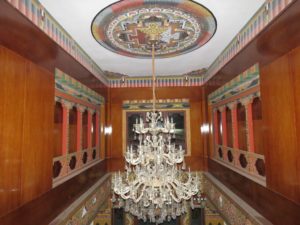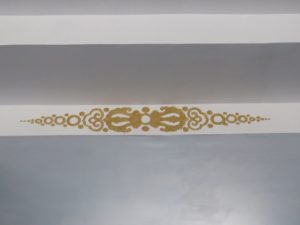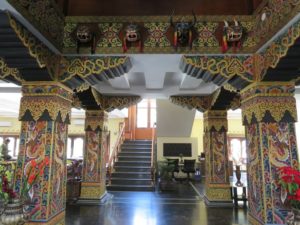Bhutan: Beauty Untamed-First Day

Bhutan: Beauty Untamed.
Last year in July, I visited Mexico for work and realized, as long as I am fit, I wanted to explore the places which are far away from home. With this in mind, I started checking out holiday destinations for our upcoming vacation.
The one which caught my eye immediately was a neighboring country which sounded magical, mystical and untamed. A quick discussion at home and we booked the tour.We were on our way to Bhutan (The Land of Thunder Dragons) – A small Buddhist kingdom perched away in the Himalayas, which still has a King, a beautiful Royal family and believes in the enrichment of Gross National Happiness rather than Gross Domestic Product for its citizens.
Even though there is an option to take a direct flight to Paro via Kolkata we decided to travel by road to Bhutan border and enter our first destination for the trip – Phunetsholing.
We took an early morning flight to Bagdogra and then drove till Phuentsholing.As it is with most country borders, on the India side is the village of Jaigaon and Phunt on the Bhutan side with a gate separating the two countries.The first thing one notices upon entering Bhutan Gate is the difference between architecture (buildings and independent houses), landscape (Plains and hills) and for me the trucks (Trucks there have different styles of eyes drawn on their front side. Try to catch the different moods through the eyes of the truck while your travel in Bhutan).
Trivia about Bhutan:
Guide: Only a certified guide can be your tour guide here. There is a course and exam to be taken to become a Bhutanese guide.
Location: Situated on the ancient Silk Road between Tibet, the Indian subcontinent and Southeast Asia, Bhutan is based on and was headed by spiritual leader Zhabdrung Rinpoche. It had multiple groups and had a civil war following which in 19th century the House of Wangchuck (Grandfather of current king) reunited the country.
Flags: The Bhutanese flag is divided in two halves with colors Yellow, Orange with a white dragon in the center called the Druk holding four jewels in its claws. The yellow color signifies the civil tradition while the orange signifies the Buddhist spiritual tradition. The Druk in center signifies the equal importance of both civic and monastics transitions in the Kingdom of Druk (Bhutan) and sacred bond between sovereign and people. The white color of Druk signifies the purity of inner thoughts and deeds of the people of Bhutan. Jewels represent Bhutan’s wealth, security and protection of its people while the snarling mouth of dragon symbolizes Bhutan ‘s deities’ commitment to the defense of the country. Apart from these you will find different types of prayer flags hoisted to house tops, hills, open fields, etc. all have significance. Those is five colors, represent the five elements of nature, those in white are raised for the souls of the family members who have passed away
Royal family: Everywhere one will see the pictures of the Beloved King and Queen of Bhutan and their son. The Bhutanese adore them a lot and they are referred as People ‘s King and Queen. If you are lucky you might catch a glimpse of the King riding on his cycle to the Thimpu Dzong.
Religion: The country follows Buddhism and has beautiful Dzongs built in each district (20 districts in total). Each Dzong has both district administration as well as religious bodies presiding over the regular operations.
Pollution: Bhutanese are very particular about honking, cleanliness and loud music. Kindly do not honk unless it emergency, do not litter and enjoy the calmness in the country.
Transport: Bhutanese vehicles are marked as BG (government), BT (Taxi), BP (Private). One can see lot of pickup truck kind of vehicles, small and electric cars. Bhutan has no railways and all transport within the country happens through roads. Road conditions vary depending on landslides and weather changes
Fauna: National animal of Bhutan is Takin. It has mixed features of deer and buffalo. Apart from Takin, Bhutan has animals like bear, squirrel, panda, Himalayan musk deer, snow leopard, tiger, wild water buffalo etc.
Army: Royal Bhutan army is the military service which includes Royal Guards and Royal Bhutan Police (We had the chance to interact with them due to an accident we had). It is trained by Indian Army. Since there is no Navy or Airforce, Indian Airforce helps Bhutan.
Economy: Bhutan’s economy is based on agriculture, forestry, tourism and the sale of hydroelectric power to India. Handicrafts, particularly weaving and the manufacture of religious art for home altars, are a small cottage industry. Thimpu recently has TechPark and helps startups via the Bhutan Innovation and Technology Center. Bhutan’s exports, electricity, cardamom, gypsum, timber, handicrafts, cement, fruit, precious stones and spices
Currency: Bhutan’s currency is Nu . 1 Nu = 1 Indian Rupee. But, do not carry higher denomination notes since they might not be accepted. Carry change when you travel.
Female population and marriage: Another sweet surprise is that the male to female ratio in Bhutan is almost equal and one will see females doing all kinds of work. In Bhutanese families, inheritance generally passes through the female rather than the male line. Daughters will inherit their parents’ house. A man is expected to move to his wife’s home
Attire: Bhutanese national attire is Gho for males and Kira for females. It was surprising to see everyone except us dressed in the national attire. Gho is a knee-length robe tied at the waist by a cloth belt known as the kera. Kira is an ankle length dress, which is clipped at the shoulders with two identical brooches called the koma and tied at the waist with kera. An accompaniment to the kira is a long-sleeved blouse, the wonju which is worn underneath the kira. A long-sleeved jacket-like garment, the toego is worn over the kira. The sleeves of the wonju and the tego are folded together at the cuffs, inside out. Social status and class determine the texture, colors, and decorations that embellish the garments. Differently colored scarves, known as rachu for women (red is the most common color) and kabney for men, are important indicators of social standing. King wears yellow scarf, Ministers – Orange, Lawyers – Blue, MPs – Green and rest – white
Cuisine: Red Rice, buckwheat and maize are staple of Bhutanese cuisine. Meat varieties of pork, yak, beef, meat, chicken and lamb are present. Dairy includes cow and yak milk and dairy products made from them. You can spot radishes, potatoes, bitter gourd, spinach, pineapples, oranges, eggplants, apricots and different varieties of dried mushrooms, beans and chilies. Do try the Salted Butter tea when you visit. The national dish Ema Datshi is made from chilies and cheese. The sale of tobacco is banned in Bhutan.
Sports: Archery is the national sport of Bhutan and is played amongst teams. Traditionally archery is a social event with food, drinks, singing and dancing included. Competitions take place within different villages, teams. To distract and opponent attempts are made by standing around the target and by making fun of the shooter’s ability. Darts and basketball are also popular in Bhutan. One can see the well-maintained football playgrounds and gyms in Thimpu.
Homes: Almost all the homes in Bhutan have 8 sacred signs and drawings painted on them with prayer flags mounted. You will also see different chilies, vegetables etc. being dried on the roof tops. The houses look pretty with all the hand painted drawings and the vibrant colors used to paint them
Indians need to take a permit when they plan to visit Bhutan instead of a visa. The permit for our group hardly took around 40 minutes and we had a 7-day pass to travel till Punakha.
Few glimpses of the border and first clicks of the hotel we stayed in. Checkout the beautiful designs on the walls and corners in the hotel (Namay Grand – Must stay).
Even the petrol pump looks charming.
Visit : Thimpu
Visit : Punakha
Visit : Paro
Visit : Phuentsholing


Decorative beam




you have written a very informative blog on your visit to bhutan.I am very impressed by the decorations on pillers beams and ceiling of hotel you stay in.
Great blog. Tag bit long,but it does bring out the greatness of this tiny but beautiful country!
Wow! Quite detailed and very informative. Greatreference for fellow travel enthusiasts! Awesome pics as well!👍